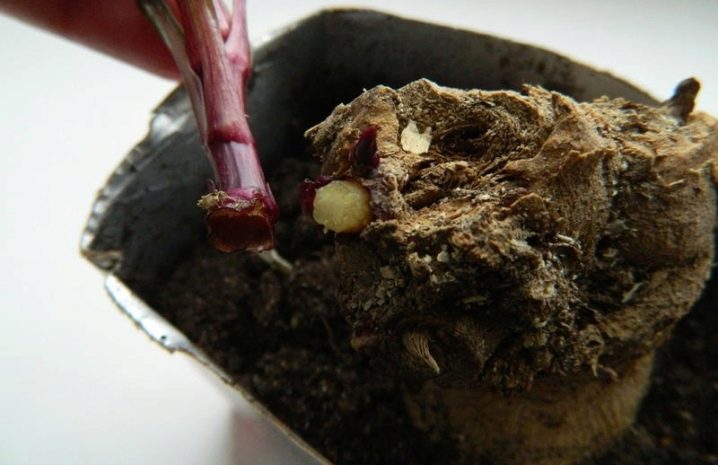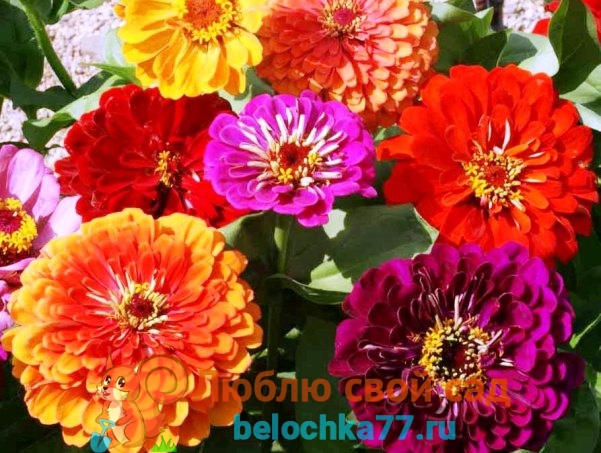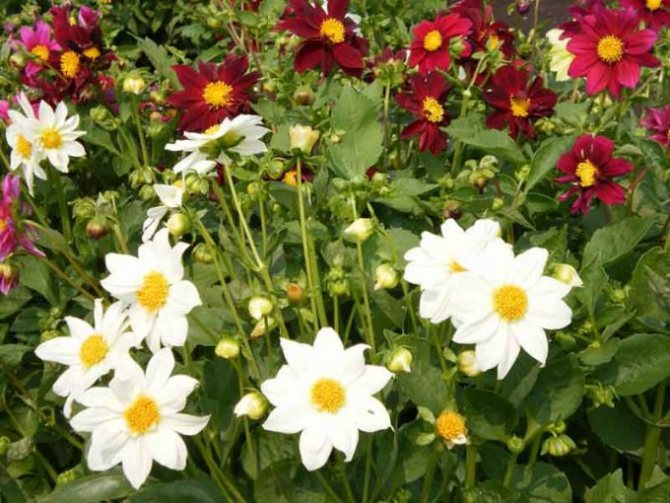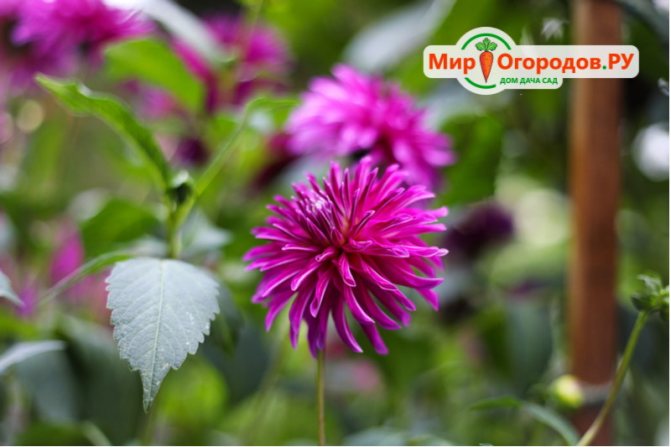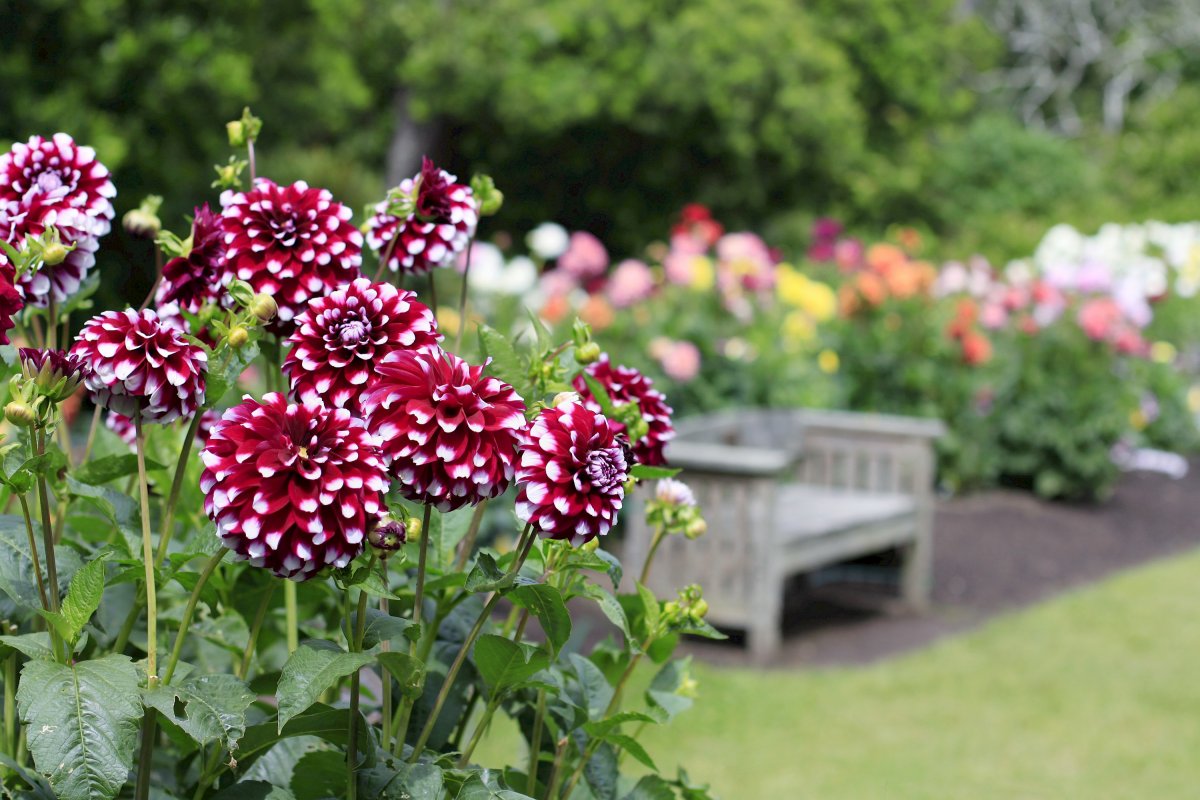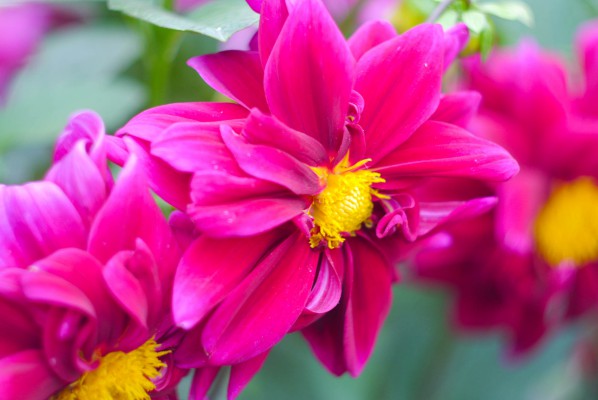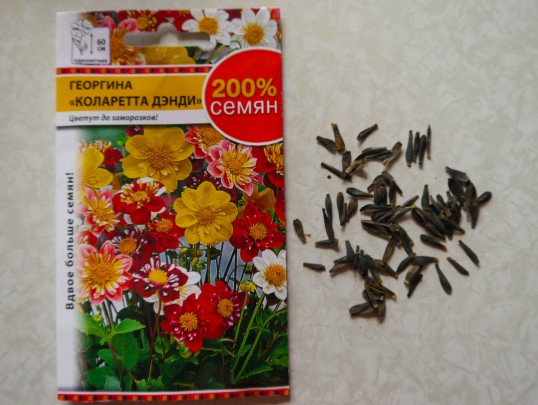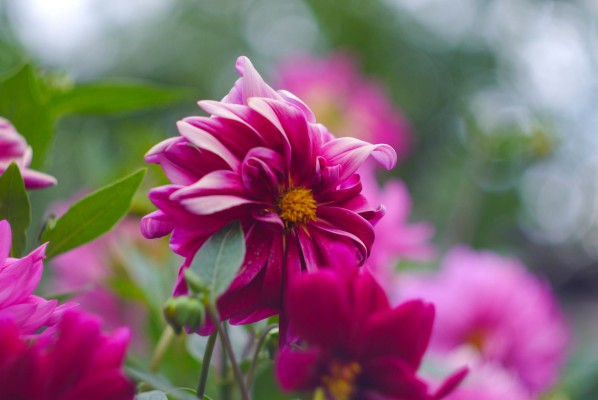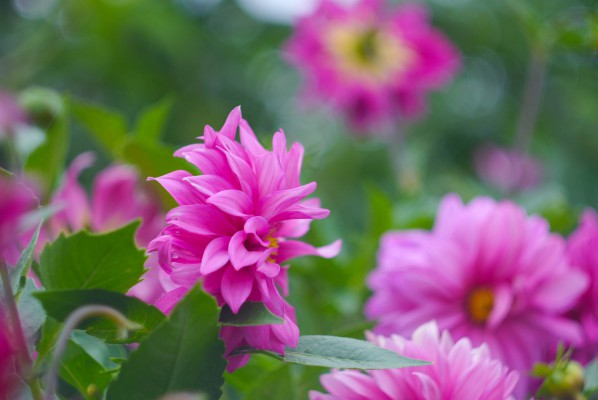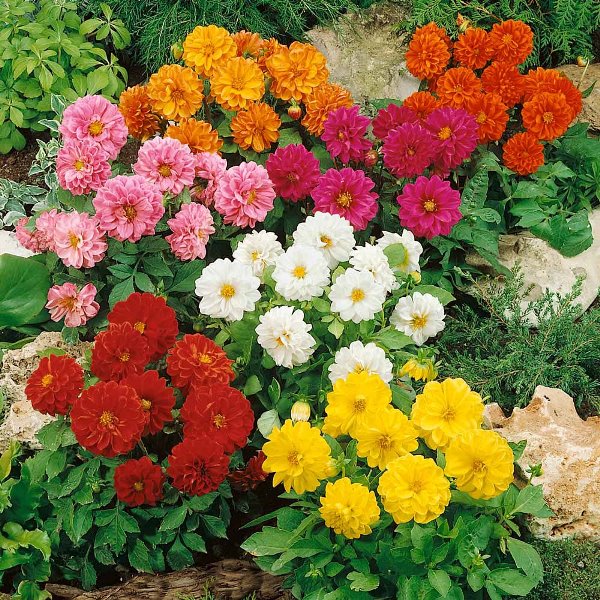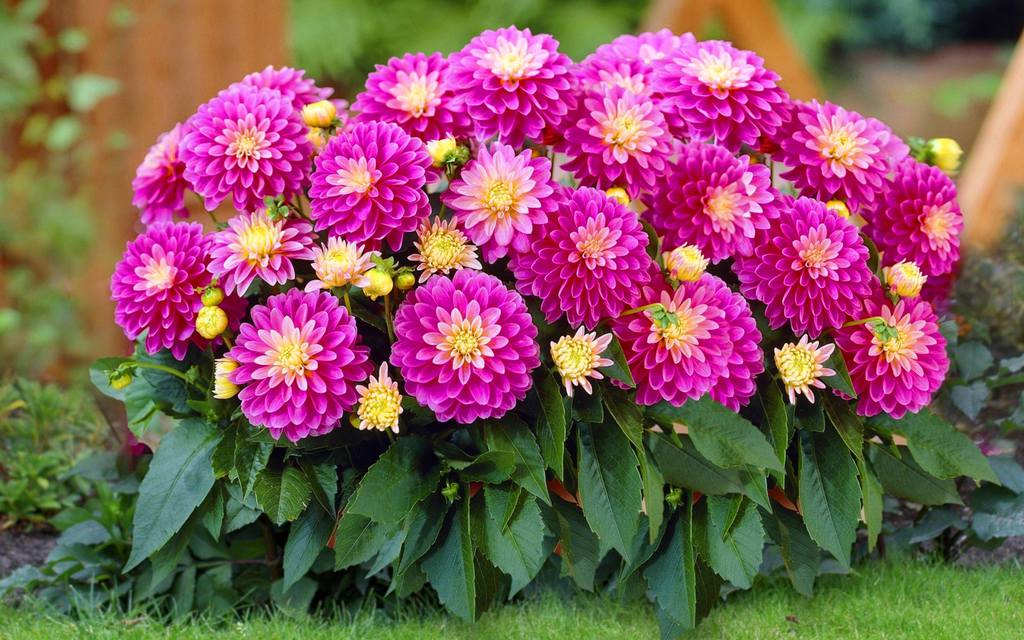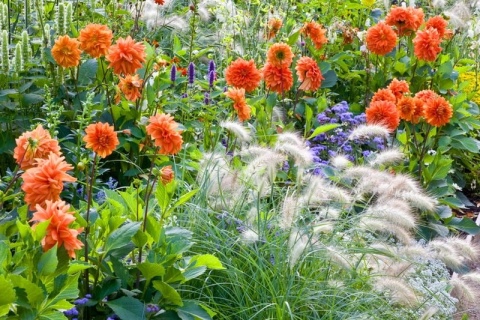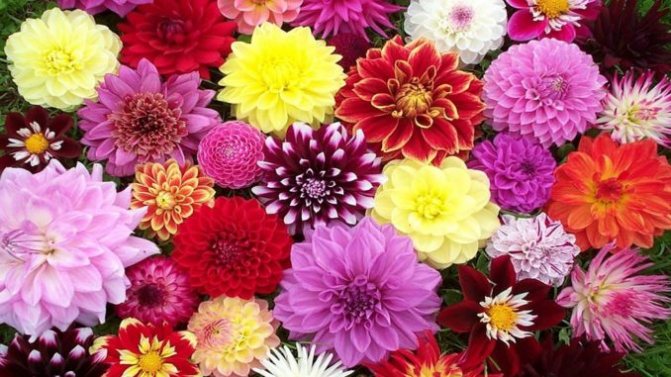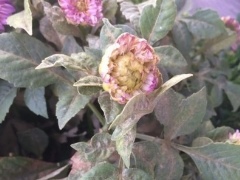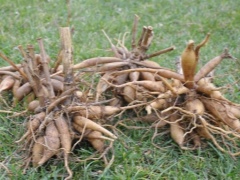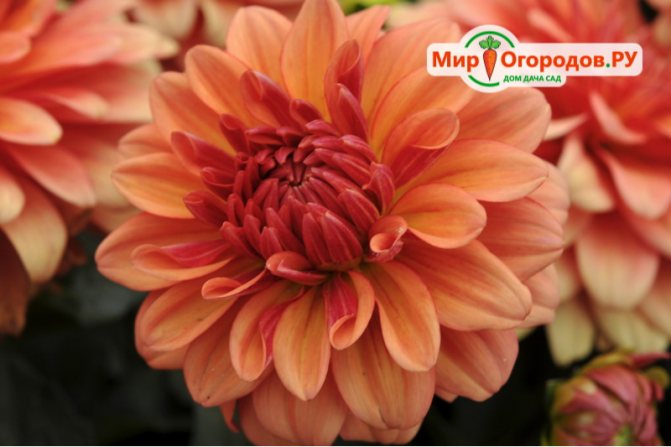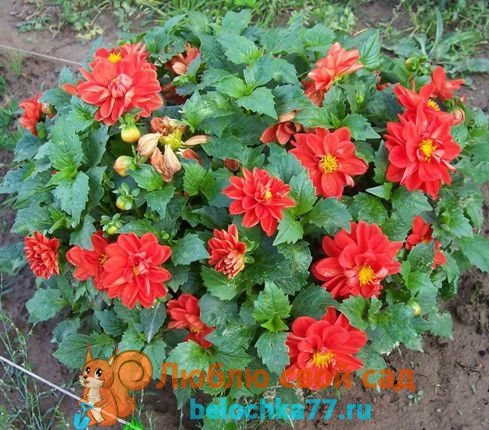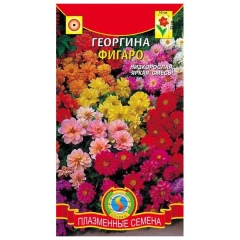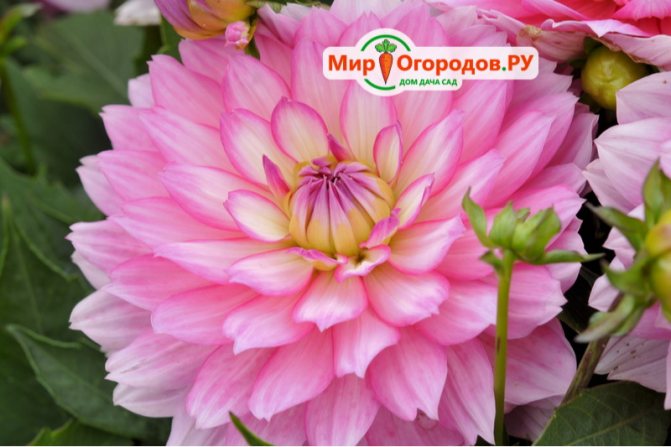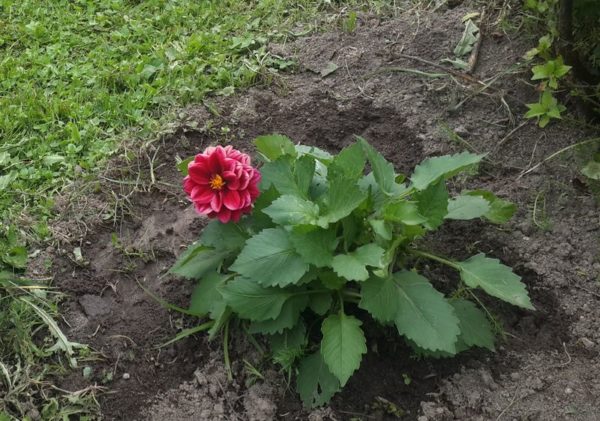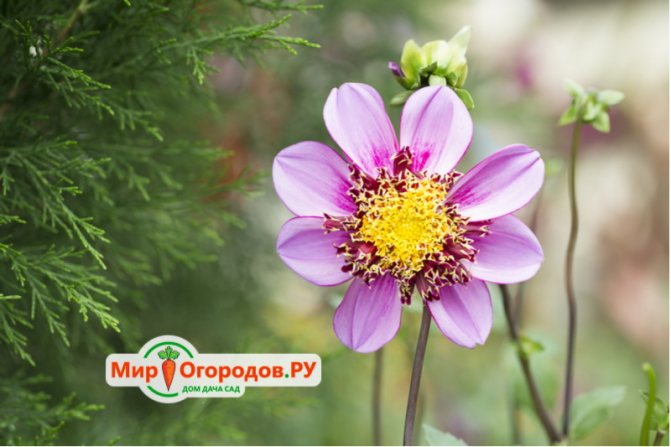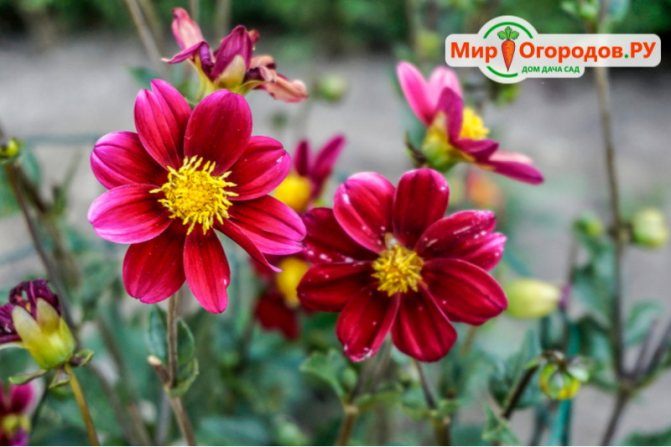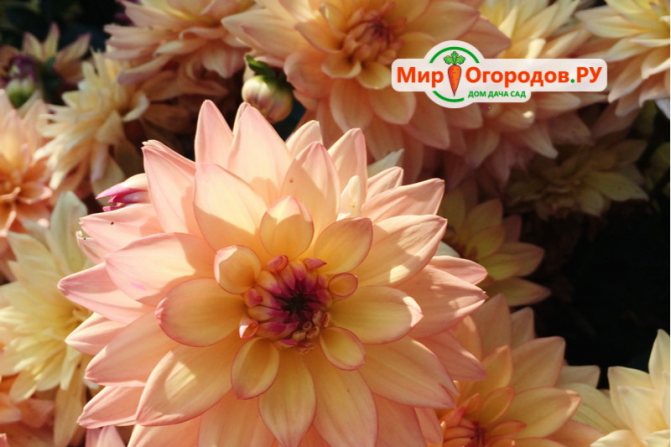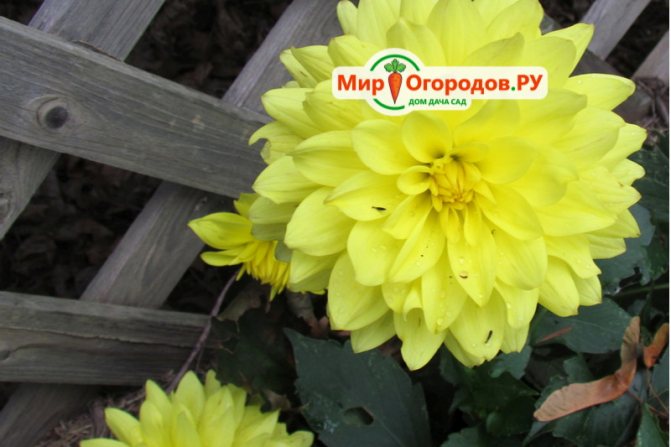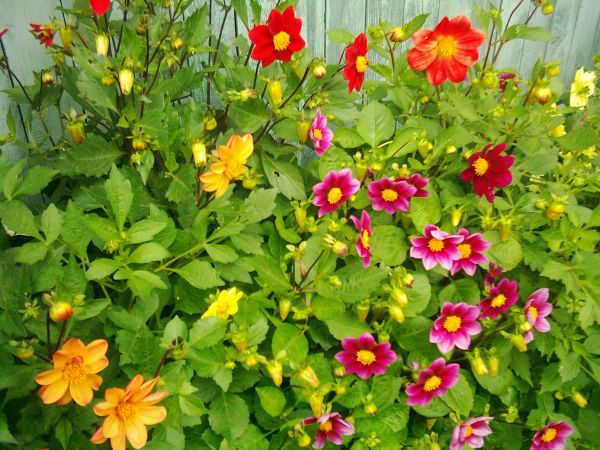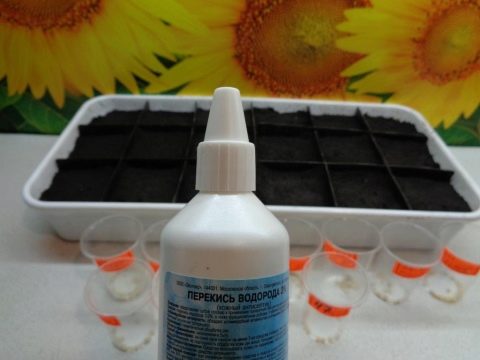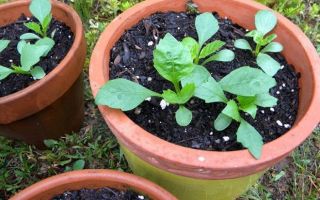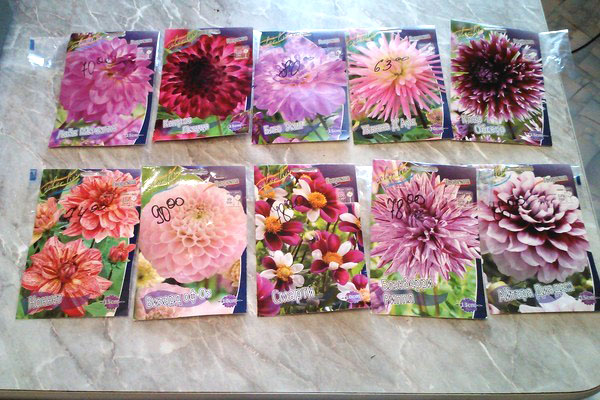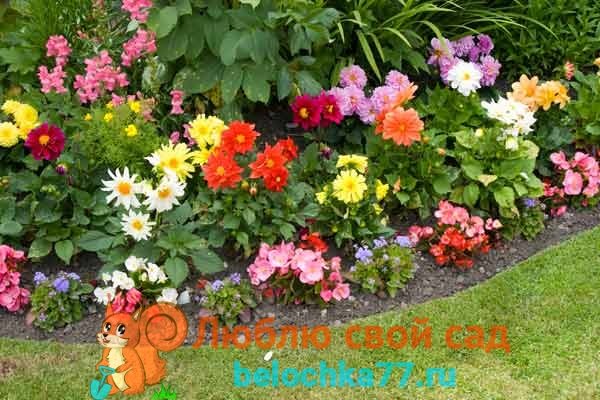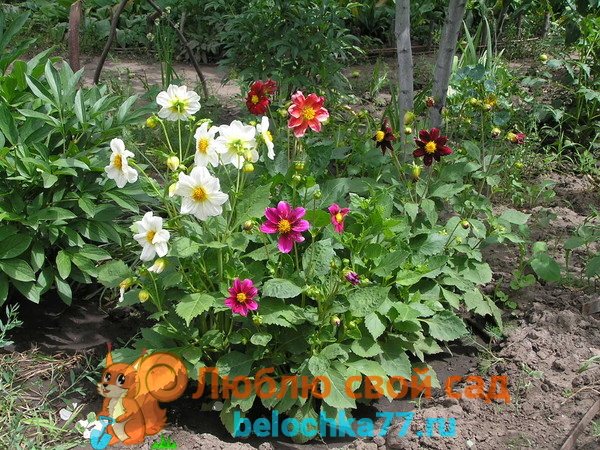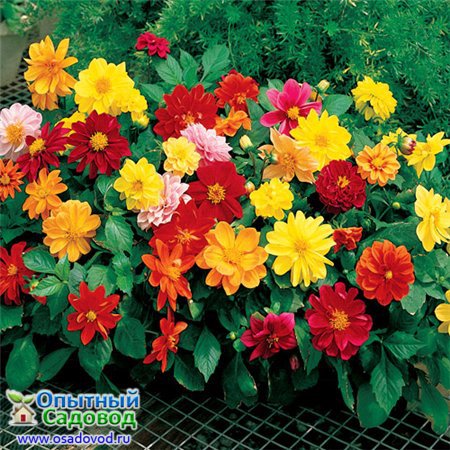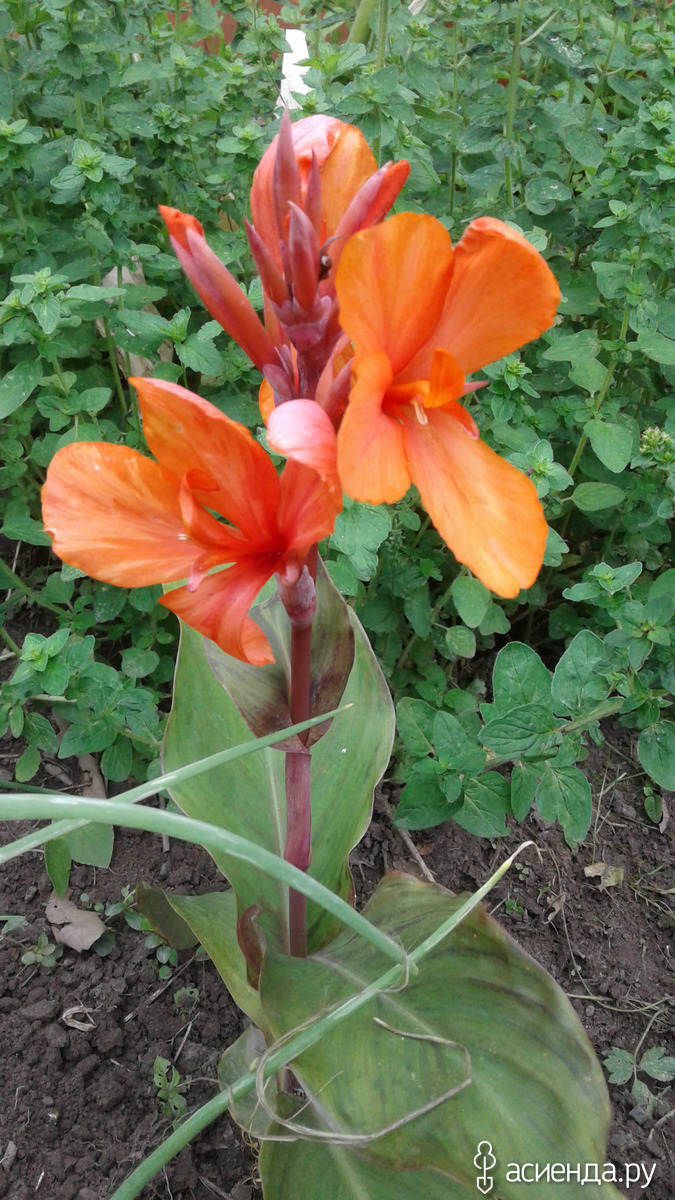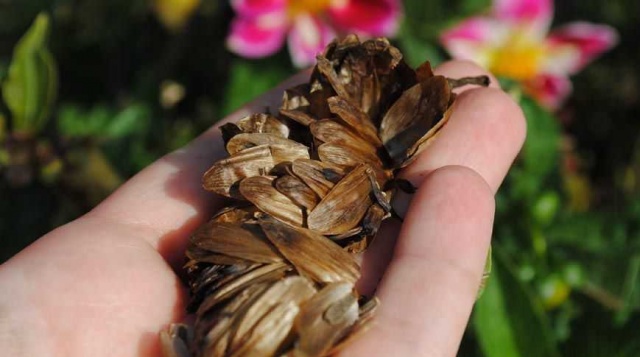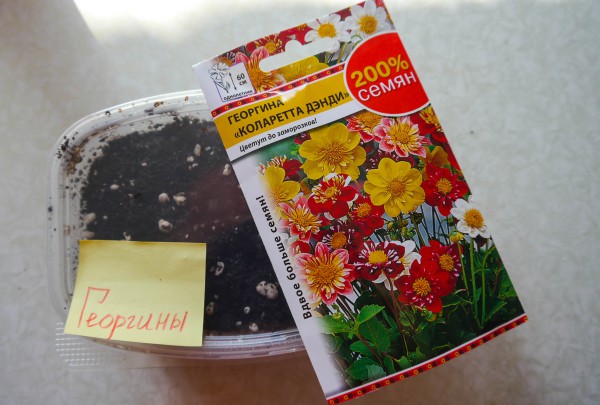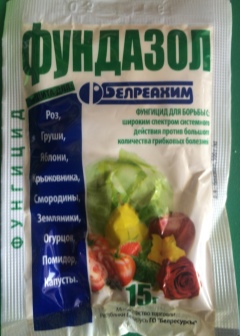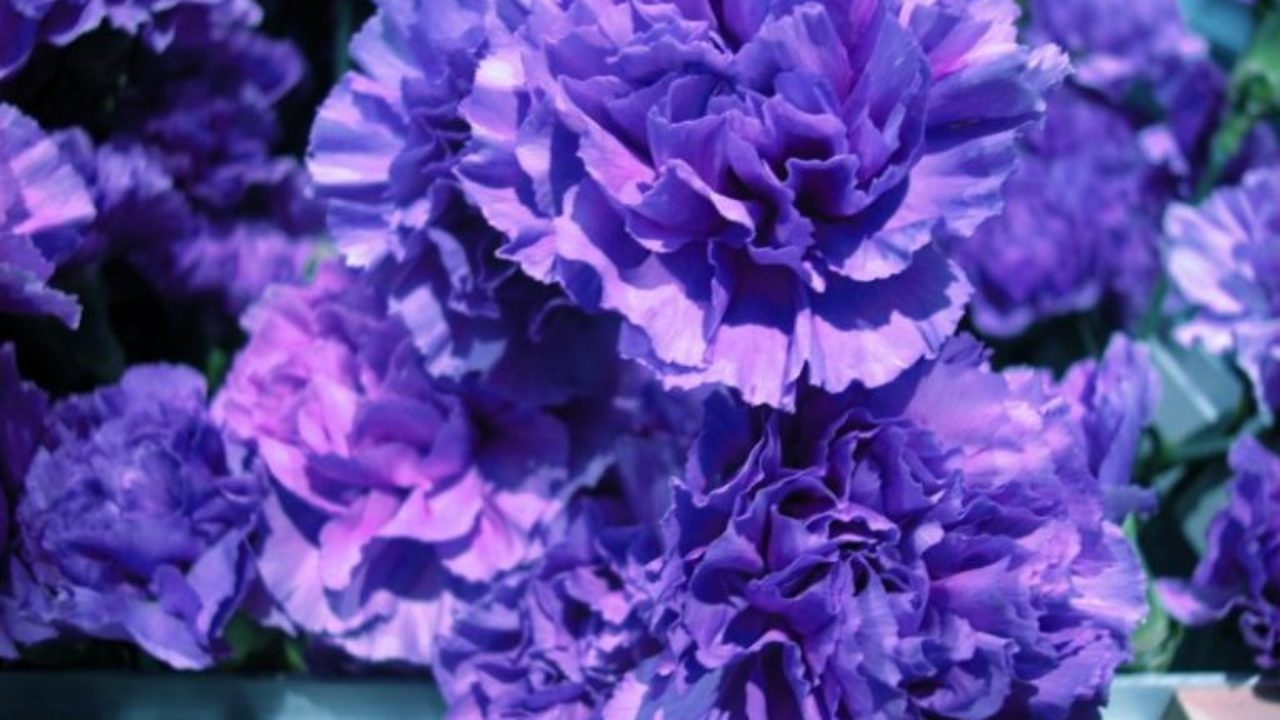Dahlia care
Dahlias are quite demanding in terms of planting conditions and further care. To achieve high decorativeness of the flower bed, it will be necessary to provide the plants with the most suitable conditions.
Watering, loosening, mulching the soil
After the seedlings settle in a new place, watering is reduced, but at the same time the soil under the dahlias must constantly remain moist. With a lack of water, the stems quickly become woody, growth slows down and flowering worsens. It is rather difficult to restore the decorativeness of dahlias after this - it returns slowly, after the onset of cool rainy weather.
To provide dahlias with optimal air humidity, moisturizing irrigation is carried out using sprinklers (with small holes). 10-15 minutes of such watering allows you to increase the humidity for a while in hot weather.
It is very important to keep the soil under the dahlias in a loosened state and regularly remove weeds. They loosen it, as a rule, after each watering or fertilization.
After buds appear on the dahlias, and the green mass of plants closes, loosening stops, and the soil is mulched with peat or humus. This is done to slow weed growth, prevent soil crusting and reduce the amount of watering, as the mulch keeps the soil moist for longer.
After the onset of stable cold weather, dahlias huddle. This will protect the roots from the first frost, while the hilling height should be 15-20 cm. If the plants were planted deeply, then hilling can be omitted.
Top dressing
The need to apply mineral or organic fertilizers for dahlias depends on the type of soil in which they are planted. Fertile soils, which were regularly fertilized with organic matter, humus, need it less. To determine which fertilizers dahlias need on a particular soil, you can hand over samples to an agricultural laboratory for chemical analysis. It allows you to plan fertilization for the next 2-3 years.
Fertilization occurs in three ways:
- when plowing the soil before planting;
- when landing in each hole;
- foliar or root dressing.
With the wrong choice of fertilizers, they can be ineffective or even harmful to plants. That is why it is recommended to regularly, once every 2-3 years, carry out a chemical analysis of the soil.
In autumn, for digging, as a rule, organic fertilizing is introduced - manure, composts, especially if they have not had time to decompose enough. In spring, wood ash, superphosphate and aged peat are plowed into the ground.
It is not recommended to introduce readily soluble chemicals into the soil, since they are easily washed out of the soil and are not used by dahlias for their intended purpose. Among such substances:
- ammonium and other nitrate;
- potassium salt;
- urea (synthetic urea);
- potassium chloride.
The latter is advised to be introduced into heavy clay soils. Fertile lands before planting dahlias are not additionally fertilized, but top dressing is applied only to the planting pits. To do this, use humus (leaf or dung) mixed with wood ash or stove soot. 3-4 tablespoons of ash are added to a bucket of compost, a quarter of a bucket of the mixture is added to each hole.
During the period of growth and flowering, dahlias are regularly fed with organo-mineral fertilizers - once every 12-14 days. To do this, use diluted cow dung or chicken manure (for 10 liters of water, 1 liter of manure solution or 0.5 liters of chicken manure solution) with the addition of potash (15 g) or ammonium (10 g) nitrate, superphosphate (15-20 g) and potassium sulfate (10-15 g). A bucket of fertilizing mixture (10 L) is divided between 4-5 plants.
Such dressings continue until mid-July, then they are replaced by phosphorus-potassium fertilizers. And after the second half of August, preference is given to phosphorus fertilizing. After each fertilization, the bushes must be watered from a sprinkler.
Question answer
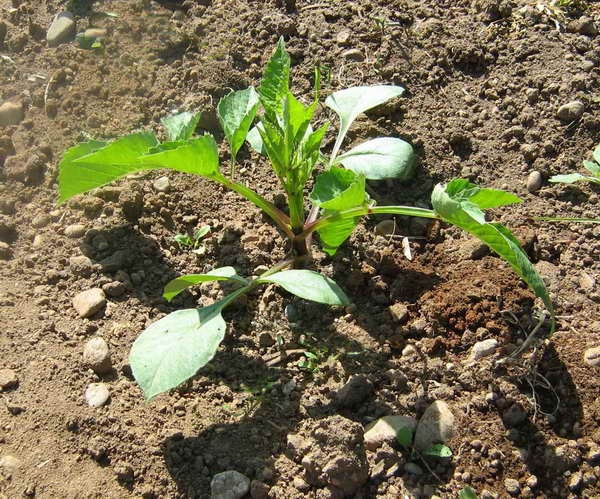
Is it possible to plant annual dahlias in the second year?
Can. To do this, you need to save the tubers of the bush. However, this will require a certain skill, the annuals have very small roots, they quickly lose moisture during storage. To find a suitable place for wintering tubers, you need to divide them into 3-5 groups and experiment with storage conditions, the main ones are:
- cardboard boxes;
- sand or sawdust for pouring;
- humidity not less than 60%;
- temperature 3-5 C above 0.
At what distance to plant annuals from each other?
Bushes grow strongly, so they need to be planted every 20-50 cm, depending on their height. Those. for low-growing bushes 30-40 cm high, the distance will be 15-20 cm, and for high varieties 90-100 cm, it will be 45-50 cm.
Is it possible to pinch annual dahlias if they are very elongated?
Dahlia pinching is carried out for both perennial and annual high and medium-sized varieties. It is necessary for:
- increasing bushiness and giving the plant a neat appearance;
- increasing the size of the flower;
- approaching flowering.
In the case of annuals, all work is aimed precisely at the formation of a large number of buds. Low-growing varieties do not dive.

When to clean annual dahlias for the winter?
The period for harvesting plants for the winter is mid-October-early November. At this time, the first frosts come, the buds fade
The tubers are carefully dug up, dried together with an earthen lump and placed in boxes with dry sand for the winter in a cool, damp place.
What if the annual dahlias don't grow?
Plants are simple, picky and usually grow well. However, there are several reasons why annuals can stop growing:
- poor quality of seeds - try to sow new ones, buy planting material in specialized stores;
- the fungus spoiled the seeds - soak the seed before planting, observe moderation when watering the seedlings;
- too hot - increase watering;
- seedlings do not grow after transplanting to the site - the land should be warmed up to 10 C above 0, carefully remove the seedlings so as not to damage the root system, regularly apply top dressing, inspect for pests, check the pH of the soil - it should be neutral.
Why aren't the seeds of the annual dahlia sprouting?
Usually seedlings sprout amicably. The first shoots appear already on the 3rd day. If this did not happen, then the reason may be as follows:
- low quality of seeds - not ripe or lost germination;
- the earth is too tightly compacted on top of the seeds;
- the seeds have rotted due to over-watering.
Are annual dahlias kept?
You can store annuals. To do this, carefully dig out the tubers after the plants have flowered, dry them, and store them in a cool place, with a humidity of 60%, sprinkled with sand or sawdust.
Why do annual dahlias have leaves curling?
There can be several reasons for twisting: lack of mineral nutrition, primarily potassium. Also, the plant may not have enough sunlight or water. Pests that feed on dahlia sap, such as aphids, cause leaf deformation.
Growing beautiful annual dahlias is easy even for a novice gardener. They can be easily obtained from seeds; if desired, they can be transformed into perennials, providing favorable conditions for wintering. The plants themselves are picky and delight with bright flowering for a long time.
Annual dahlias - how to choose the right variety?

First of all, you need to decide on the type of flower. Today, more than 50 types of dahlias are known, each of which differs in height, flowering period and color. Many people prefer varietal mixtures, which allows them to end up with low-growing flowers of various shades. This beauty will certainly please you and will decorate your summer cottage.As for the purchase of planting material, it is necessary to give preference to specialized stores.
The plant grows best of all on loose, neutral and non-acidic soils.
Particular attention should be paid to fertilizers, which are applied a couple of times a year: in spring and autumn. When can you sow dahlias? Experts advise growing seedlings from seeds
In this case, it can be planted in early April, and the flowers will bloom in early summer. If you decide to immediately sow seeds in the ground, then keep in mind that the most suitable time for this is the end of May, but flowering will be in mid-August.
Caring for annual dahlias
Let's take a closer look at how to care for annual dahlias so that the flower garden can be considered a real source of pride. To do this, you should regularly remove weeds from the flower garden and fluff the soil in it, do not forget about periodic (no more than once every 7 days) watering, maintain the recommended intervals between the bushes and from time to time carry out top dressing. Annual dahlias, planting and caring for which are carried out according to these simple rules, compare favorably with their fellow tribesmen, which are grown at random.
How to feed annual dahlias?
Such are these decorative flowers, annual dahlias, that planting and caring for them is simply impossible without a little "doping". The first feeding is carried out at the seedling stage, about 20 days after sprouting from the ground. A ready-made mineral complex with a high nitrogen content is used as the first fertilizer. Annual dahlias, planting and caring for which are accompanied by regular (every 15-20 days) application of a small amount of fertilizer for flowering plants, start growing faster, bush more actively and form large inflorescences.
Pinching annual dahlias
The question that is relevant for all gardeners who are taking the first steps in breeding dahlias is how to pinch annual dahlias and is it necessary to do this at all? Pinching the central stem helps to form a lush bush and stimulates abundant and earlier flowering. To get the largest flowers possible, in addition to pinching the stem, it is also recommended to remove (pluck) excess buds. This procedure forces the plant to direct all its forces and nutrients not into the leaves, but into the flowers.
Transplanting annual dahlias
Like other flowering plants, dahlias should be disturbed and transplanted from place to place only in the most extreme cases. The safest way to transplant annual dahlias is to move them to a new place of residence along with a lump of earth. It will not be superfluous to add a little wood ash to the planting hole, and water it abundantly after planting. It is best to carry out such work in cloudy, cool weather.
Self-collection of dahlia seeds and their selection for sowing
Abundant fruiting is one of the reasons why annual dahlias are considered easy to grow and “budget” plants, an excellent alternative to perennial crops. After the end of flowering, the achenes of the fruits ripen, from which, after drying, you can get a generous harvest of seeds. And although they will give offspring with a wide range of characteristics and will not allow exactly to preserve the characteristics of the mother plant, nevertheless, self-collection of seeds is very popular.
On average, you can collect seeds from the bushes within a month after the baskets have flowered, cutting off the hemicarps whole. Dahlia baskets are dried in a ventilated and dry place at normal room temperatures. Seeds can be removed only after the seed is completely dry.
You can also store dahlia seeds at room temperatures. Heat and high humidity, like light, are indicators from which they should be protected. Dahlia seeds keep well in simple paper bags.
When buying dahlia seeds in a store, you should pay attention to three parameters:
- On the doubleness of the inflorescences.
- Color nuances.
- To the height of the plants (the higher the variety, the longer the growing season and the more limited the possibilities of its use in decorating the garden).
Dahlias can hardly be called elite plants, their seeds are available and found everywhere. When choosing quality seeds, it is enough to show the usual care. If you buy rare varieties and mixtures of varieties or new varieties, then it is better to choose producers that have proven themselves well with other new plants.
When choosing seeds, pay special attention to the recommended uses, especially if you want to grow dahlias in curbs or containers rather than in flower beds.
Proper preparation of tubers
Dahlia rhizomes are removed from cold storage at least 2 weeks before planting to awaken the buds and a maximum of 2 months for germination of late varieties and early medium and late flowering. If you buy planting material in a store or at the market, then do it in the fall, when the rhizomes have just been dug out of the ground and are still fresh. Store them on your own until spring. When buying tubers, you must have:
- elastic, not flabby or dry;
- no traces of rot or mold;
- without damage;
- with a root collar and the remainder of the stem.
Tubers broken off from the stem do not germinate. They don't have eyes like potatoes. The buds are laid only in the upper part, which they hold on to the stem (root collar).
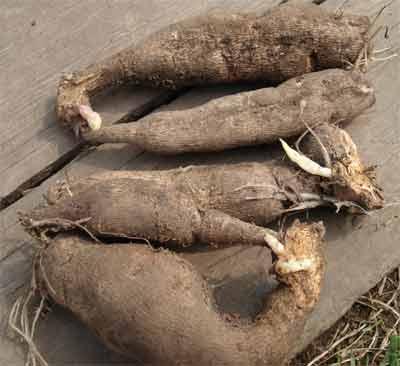
One tuber can be planted, it will sprout, if its upper part is intact - the root collar, it has a bud
Stages of preparation of planting material for dahlias:
- Bring the rhizomes from cold to warm gradually: first, keep for 1-2 days in a cool place, for example, in the corridor, near the balcony door, etc.
- Rinse under running tap water at room temperature.
- Etch in a solution of potassium permanganate, copper sulfate (1 teaspoon per 10 liters of water) or any fungicide according to the instructions. Let the water drain, pat dry.
- For germination, prepare boxes, trays, cellophane bags, basins, etc. Drainage holes are required to exclude stagnation of water at the bottom and rotting of tubers.
- Pour a thin layer of loose substrate, lay the rhizomes and cover on top so that the root collar remains open. Wet sawdust, peat, coconut fiber, sand will do.
- Place the containers with the sprinkled roots in a bright and warm place (+ 18… +20 ° C).
- Moisten the substrate periodically, but do not flood.
- After 2 weeks, the kidneys wake up, you can start dividing and planting.
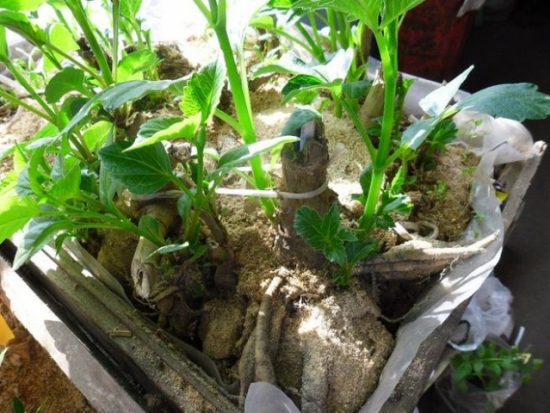
The tubers are covered with a moist substrate and germinated in the light.
The number of buds will show how many stems each rhizome will give. Do not think that the more of them, the more lush the bush and the more abundant flowering. Quite the opposite - numerous stems push each other, spend energy on competition for light, water and food, so flowering is poor.
If 4–5 or more buds have woken up on the rhizome, then it makes sense to divide it into parts with 1–2 buds on each. In this case, the incisions must be made by grasping the stem in order to preserve the root collars.
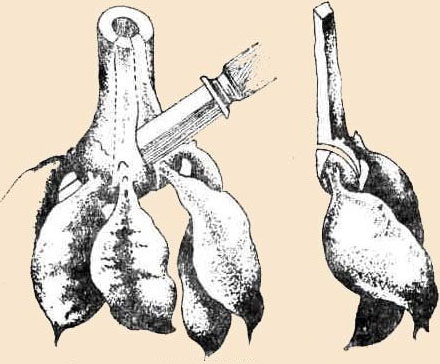
The root must be divided so as to preserve the root collars and buds on them.
Too dense rhizomes can be difficult to divide without damaging the tubers. Powder all slices with crushed charcoal or brush with brilliant green.
Video: dividing dahlia roots
If the heat is still far away, you need grown shoots for early flowering, then plant the tubers temporarily in pots or buckets with nutritious soil. Once every 10 days, but no later than a week before disembarkation, feed with a complex universal mixture, such as Fertiki Lux.
The most sought-after varieties of annual dahlias
Varieties of annual dahlias that have won everyone's attention: "Funny guys" - perhaps this is the most popular variety, you can also call it: "Piccolo", "Harlequin Mix", "Figaro Mix". All of these plants reach a height of 30 cm
and bloom with non-double flowers.There are also pompom annual dahlias, but their flowering is not as lush as in non-double varieties.
Funny boys
The variety has won universal recognition. Due to the lush flowering, summer residents-gardeners willingly choose it to decorate flower beds on their site. Single-row tubular flowers, resembling a basket, reach a diameter of 10 cm. The "Merry Children" bloom all summer, and the cheerful colors of huge flowers delight the eyes of their owners. Dahlia flowers can be simple and double, the plants themselves are undersized (up to 25 cm) and giants, the height of which is equal to 70 cm. "Merry Guys" are annual plants that do not form tubers.
Dandy
Many are delighted with the semi-double flowers of this variety. Original flowers of various colors are decorated with collars. The variety belongs to undersized plants. Suitable for decorating ridges, mixborders, for planting near curbs.
Piccolo
Annual undersized dahlias, their height is only 40-45 cm. Look great in flower beds. Also, they are grown as a pot plant. Blooming "pompoms" in flowerpots can be used to decorate a terrace, veranda, balcony.
Unwins Dwarf
Branching stems of the plant reach a height of 60 cm.Semi-double flowers, 6 to 9 cm in diameter, completely cover the plant
Lively shades of flowers attract attention to themselves. Flowers can be red, yellow, carmine purple, white and pink
Dahlias continue to bloom until frost. Suitable for border decoration, planted in flower beds and ridges. Combines with lavater, cosmea, aster and sunflower. From perennial plants in the neighborhood, you can plant coreopsis.
The seeds are buried in the ground to a depth of 0.2 cm. After 4 weeks, the seedlings must be cut open, leaving a distance of 4 cm between them. In early June, the seedlings can be planted in a flower bed. Planting is done in loose, limed, fertile soil. The variety prefers a sunny location.
Popular varieties of annuals "Lark" and "Mary" of various names are characterized by long flowering and compact size. Their height is up to 60 cm. A variety of terry, cactus, pompom, semi-double and spherical inflorescences can decorate the garden from June to the very frost. In addition to their beauty, these plants have a pleasant smell that attracts bees and bumblebees. Gardeners and gardeners take advantage of this and plant them near vegetables. Insects, arriving at a flower, pollinate vegetables at the same time, so success in a rich harvest will be guaranteed.
The use of flowers in landscape design
With the help of "Funny guys", this is how annual dahlias are called, you can, without straining, decorate your garden. Plants are suitable for growing in flower beds, for decorating borders. They look beautiful if planted on a gentle slope on the south side. You can grow them like potted plants, decorating them with a terrace, balcony and loggia.
Dahlia care
Further care is quite standard:
- watering;
- loosening and weeding;
- feeding.
Dahlias love water, but do not tolerate excess moisture. Based on these requirements, as well as taking into account weather conditions, it will be necessary to determine the irrigation schedule.
In hot weather, water is often watered (up to twice a week); on cloudy rainy days, the plants usually have enough rainfall. If it is very hot, you can lightly sprinkle flower leaves with water from a spray bottle in the evening. From about mid-August, watering and feeding are stopped.
After watering, it is recommended to loosen the soil so that a hard crust does not form on the surface. Mulching is effective in this case, for which sawdust, mown grass, peat, well-rotted compost or humus are suitable. All weeds are removed without fail, which not only take useful nutrients from the soil from dahlias, but can also inhibit plants and serve as a source of various infections.
During the season, dahlias are fed several times, while at the beginning of the growing season, nitrogen fertilization should prevail, later - phosphorus and potassium. If the soil was well fertilized during digging, then this will be enough and nitrogen can be omitted.
The first feeding is carried out no earlier than two weeks after the dahlias are planted in open ground.
ON A NOTE! When overfeeding flowers with nitrogen, only one green mass is collected, and few buds are tied.
Excess nitrogen is also the cause of fungal diseases, so all fertilizers are applied exactly according to the norms. During the period of budding and flowering, two or three additional dressings will be quite enough. Suitable:
- complex fertilizer for flowers;
- infusion of wood ash;
- superphosphate and potassium sulfate.
To get more buds on the side shoots, pinch the main stem of the dahlia. The buds that have faded must be removed. To obtain seeds, leave a few buds at the end of the flowering period.
In the last days of August, at the beginning of autumn, there are already cold nights in many regions, there is a possibility of cold snaps. Dahlias can be covered with non-woven fabric, and during the day, when it is warm, the plants can be opened. Such measures will extend the flowering of these wonderful plants by one and a half or two weeks.
In case of violation of the rules of agricultural technology: thickening of plantings, improper watering, which led to waterlogging of the soil, dahlias can be affected by diseases. Among the common ones:
- leaf spot;
- fusarium;
- white rot;
- verticillosis.
For treatment, drugs Oxyhom, Fitosporin are used (used according to the instructions), and the affected parts of the dahlias (or the plants themselves) must be removed from the beds.
From aphids, whitefly caterpillars, whiteflies, treatment of dahlias with Fitoverm, infusions of ash with the addition of soap, infusion of garlic or tobacco dust helps. For slugs, if they are present in small quantities, dusting the soil around the flowers with wood ash, ground pepper, as well as manual collection of insects helps. If there are a lot of slugs (for example, in a rainy summer), then you will have to use granules of the Thunderstorm, Slime-eater or superphosphate preparations.
Gardeners' mistakes when growing dahlias
Even if all the conditions for growing dahlias are met exactly, many gardeners are often unhappy with how the plants bloom. There is a slow blooming of flowers, underdevelopment of most of the buds.
It turns out that this is due to the fact that the bushes of the annual dahlia, unlike the perennial, are very spreading. Each leaf axil gives birth to young shoots, and they all bloom. This is due to the long flowering of a plant with many flowers. However, only the central trunk of the plant and the apical shoots have time to fully mature. Due to the fact that more light falls on them, the buds appear on them much earlier and, accordingly, they have time to grow.
Why don't the flowers have bright colors? The flower spends a lot of effort to form the lower lateral shoots, and this greatly slows down the color on the other shoots. To avoid this, at the very beginning of formation, the flower is stepson (see the photo below for help).
This should be done regularly. All the lower lateral shoots on the plant are broken weekly. The flower is shaped as follows: the central stem and about 3-4 lateral branches are left. If this is not observed, we will get a disheveled bush, in which flowering will linger, and most of the buds will remain underdeveloped.
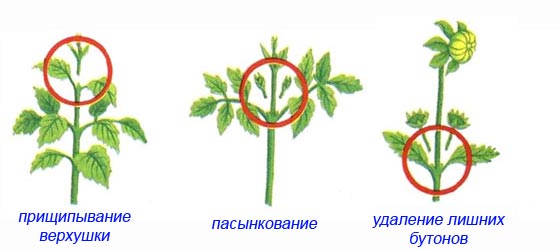
Features of planting annual varieties of dahlias
Planting and caring for annual dahlias is easy. These plants are propagated by seeds, which can be purchased at the store or harvested by yourself after flowering. There are no special requirements for the composition of the soil - the plants take root well and bloom in almost any conditions.
Seed selection
The stores sell different varieties of dahlias and their combinations. Before buying, it is worth deciding for what purpose the flowers will be grown.There are a huge number of plant varieties that differ in height and shape. On sale you can find collared annual dahlias, as well as cactus and other varieties. The best option for decorating a garden is the collection marked "Mix". They contain seeds of different varieties, approximately the same in height. If you plant them in open ground, the flower beds are lush and bright.
Landing in open ground
Seeds of annual dahlias can be planted in open ground without prior preparation. The procedure is carried out in May, when the soil warms up enough. If you plant the seeds before the air temperature rises and stays stable at 20-25 degrees, they may not sprout.
Planting and caring for annual dahlias is carried out in several stages:
On this topic:
BACK
FORWARD
1 of 3
- the soil is pre-loosened, you can add a small amount of organic fertilizers;
- seeds are placed at a distance of several centimeters from each other;
- after 7-10 days, the first shoots appear, and when they begin to grow intensively, they get rid of the weakest representatives so as not to interfere with the growth of healthier plants;
- dahlias are periodically watered in drought conditions.
The main challenge is when to plant annual dahlias when grown from seed. May is the optimal time in a temperate climate, but you should be guided by the temperature of the air and soil. In addition, with this method of planting, the time for the appearance of buds is shifted. The first flowers begin to bloom in August, when the rest of the summer plants are already starting to fade, and remain until the frost begins.
Growing seedlings
A more laborious way to grow dahlias is with seedlings. It is chosen so that the first bright inflorescences appear in late May or early June. To do this, it is necessary to prepare separate pots or boxes for seedlings, soil and seeds at the beginning of spring.
On this topic:
BACK
FORWARD
1 of 3
When growing annual dahlias with seedlings, it is worth acting according to a certain algorithm:
- in April, seeds are scattered over the surface of the soil in one large box, they are covered with earth from above and tamped a little;
- the first shoots will begin to appear in a week, and the plants may become cramped in one container;
- when the first pair of leaves grows, each flower is placed in a separate small pot;
- already grown dahlias are planted in the ground at the end of spring, and very soon the first inflorescences begin to appear on them.
In May, when the air temperature becomes steadily high and does not decrease at night, the seedlings can be planted in open ground. Average varieties of dahlias are located at a distance of 30-60 cm from each other, but this figure depends on the type of plant. Before planting in the soil, seedlings of annual dahlias must be hardened. To do this, it is worth leaving a container with young flowers on open balconies or first taking them out into the street in the daytime.
When you can't deal with flowers
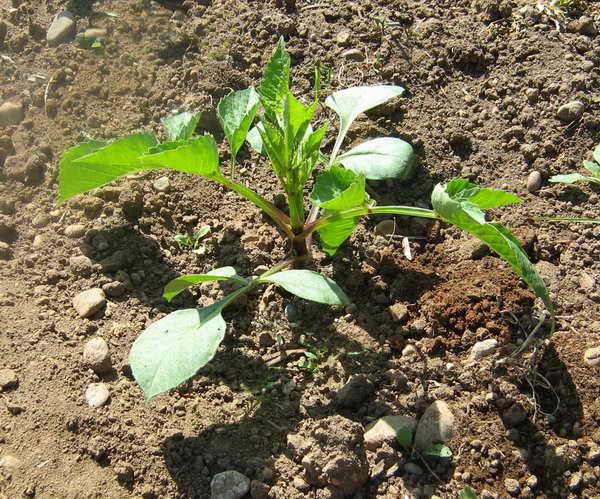 In addition to favorable and unfavorable days, there are dates in the lunar calendar on which any manipulation with flowers is strictly prohibited. The negative influence of the celestial body is so great that flower growers should abandon all plans related to growing flowers these days.
In addition to favorable and unfavorable days, there are dates in the lunar calendar on which any manipulation with flowers is strictly prohibited. The negative influence of the celestial body is so great that flower growers should abandon all plans related to growing flowers these days.
Days of the spring-summer season 2020, in which you can not do flowers:
- March - 9, 24;
- April - 8, 23;
- May - 7, 22;
- June - 5, 21;
- July - 5, 20;
- August - 3.19.
If the plant has already bloomed, then it cannot be transplanted even on favorable days. It can get sick and not take root.

Ways to store dahlias in winter at home
Description
Dahlia belongs to the Asteraceae family. Its plants can be annual or perennial, and many gardeners prefer the first type.The fact is that this thermophilic flower cannot winter in the middle lane, so the tubers have to be processed and stored until the next sowing. This creates certain difficulties, since during the winter they are often affected by diseases and dry up, so it is much easier to grow annual dahlias.
Bush of annual dahlias
In terms of their decorative properties, they do not differ at all from their perennial counterparts. These are low (about 80-120 cm) plants, the diameter of the flowers is about 10-12 cm, and 10-15 flowers can bloom on one stem at once. They bloom in June-July, and retain their bright colors until late autumn.
Dahlias - queens of the autumn garden
Growing dahlia from seeds
Preparing seedling containers
Sowing is carried out in boxes, containers, pots, while usually first sowing seeds in one common container, and then diving into separate pots.
ON A NOTE! For growing dahlias, peat cups, tablets, cassettes, ordinary plastic glasses with a volume of 200 ml (with a mandatory hole in the bottom) are suitable.

Either purchased material or harvested from the fall is used as a soil. The soil for seedlings should be loose, nutritious, breathable. It is advisable to warm up the soil before sowing seeds, and also to disinfect it with a solution of potassium permanganate.
Germination of seedlings
Seeds are sown in boxes in grooves, in separate pots they are sown in holes. Cover the containers with foil, put them in a dark and warm place (the temperature should be at least + 23ºC).
If everything is fine, then in about 8-10 days there will be the first sprouts. Then the film is removed, the seedlings are exposed to a lighted place. The temperature can be slightly reduced to + 18ºC so that the seedlings do not stretch too much. Then the stable mode is set at + 23… + 24ºC.
It is better to water dahlia seedlings from a spray bottle, preventing moisture from entering the seedlings. The soil should be slightly damp, moisture should not stagnate.

Seedling picking
A pick is done when the seedlings have 3-4 leaves. This is usually done for seedlings that were first sown in a common box. Dahlias tolerate picking well, but you should not forget about accuracy
It is important not to damage the thin roots of plants, do not overflow seedlings in a pot
After picking, the seedlings will adapt for several days, and then they will grow. Care is usual: watering (as the soil dries up), loosening. You can also feed the seedlings with a special fertilizer for flower seedlings.
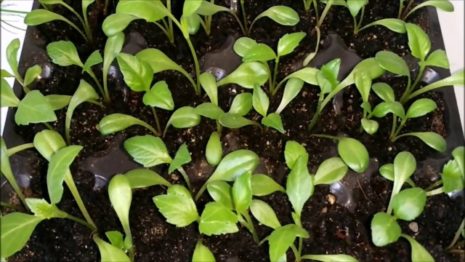
Planting flowers in open ground
May and early June are the time when warm days come, the air temperature stabilizes and you can plan to transplant dahlias into the open ground. For two, or even three weeks, the seedlings are hardened, taking them out into the open air. At first, the time of air procedures should not exceed 10-15 minutes, then the duration is gradually increased.
IMPORTANT! You cannot immediately, without hardening, transplant seedlings from home conditions into the ground. For plants, this is a strong stress, they will take root in the garden for a long time .. Dahlias that have been hardened take root faster, which means they will begin to bloom earlier
Dahlias that have been hardened take root faster, which means they will begin to bloom earlier.
Seat selection
Do you want to get a beautiful and lush bloom of dahlias? Then you need to take care of the correct selection of a place for a flower garden. A sunny, wind-protected area would be the best choice. Dahlias can tolerate a little shading, but it is still advisable to provide the flower garden with good lighting throughout the day.
Soil preparation
Handsome dahlias are not picky about the soil, but their flowering will be long and abundant on nutritious and loose soils. Plants prefer neutral acidity, therefore, if the soils are acidic, dolomite flour or fluff lime should be added.
IMPORTANT! Groundwater should not pass near the planting site, otherwise the root tubers of dahlias will suffer from stagnant moisture.
These flowers always grow well in elevated areas, with soil well fertilized in autumn. All fertilizers (humus, compost, ash or complex compounds) are best applied in the autumn, for digging. In the spring, it remains only to dig up, loosen the soil and prepare holes for planting seedlings.
Planting flowers on a flower bed
Planting of seedlings is carried out according to the scheme, while the distances between seedlings are determined taking into account the variety and height of the stem. For low-growing varieties, 20 cm will be enough, for taller dahlias 40-50 cm are left. Humus, superphosphate are added to the holes (you can use wood ash), spilled with water. Seedlings are planted carefully, trying to get them out of the pots along with an earthen lump.
 ON A NOTE! Two to three hours before transplanting, the pots can be spilled abundantly with water, then it will not be difficult to get the plants along with a lump of earth.
ON A NOTE! Two to three hours before transplanting, the pots can be spilled abundantly with water, then it will not be difficult to get the plants along with a lump of earth.
When growing seedlings in pots from peat, they are planted without removing them from the containers. This is one of the best options as the dahlia roots will not be damaged. After transplanting, the land near the plants can be mulched.
Landing
Dahlias are very demanding on living conditions, so when planting plants, you should be very careful when choosing a site for a future flower bed. These plants prefer warm and well-lit areas. For full growth and flowering, plants must be exposed to sunlight for at least 7-8 hours a day. The place should be not darkened, but at the same time protected from strong winds and drafts.
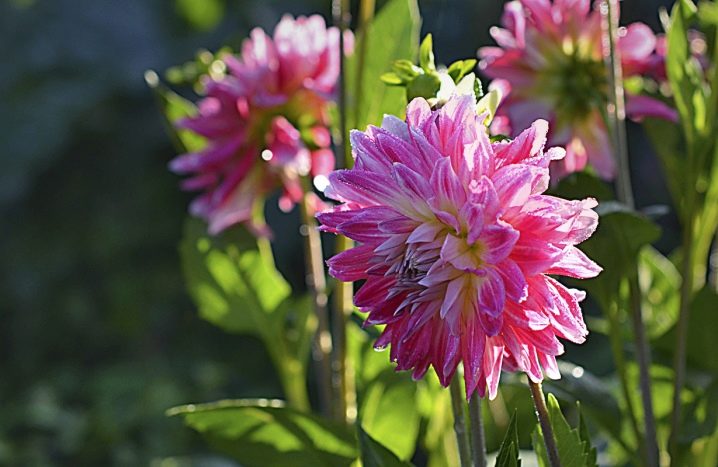
For the propagation of cactus dahlias by the seed method, planting work should begin in March. In this case, the seeds are planted in a substrate consisting of peat and sand, lightly sprinkled, moistened with a drip method and covered with a film to create the effect of a mini-greenhouse. The greenhouse should be aired and watered daily as soon as shoots appear - the film can be gradually removed.


Dahlias can be planted with tubers. To do this, in April, the rhizomes are placed in a mixture of peat with sand or wet sawdust, providing sufficient light. As soon as the buds appear, it is necessary to immediately divide the tuber into 2-4 parts so that each has its own bud, after which the tubers are kept in the soil mixture until May. When the threat of return spring frosts has passed, they choose healthy planting material without visible damage and proceed directly to planting.
Planting holes are made with a depth of 15-20 cm, with a step of 50-70 cm, depending on the variety series. If you plant tall dahlias, the distance between the bushes should be greater.

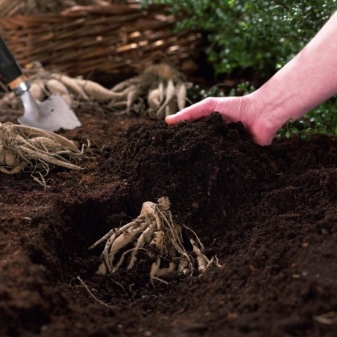
The method of planting by cuttings is no less popular. To obtain them, in the first half of March, the tubers are placed in wet compost and await the emergence of shoots. As soon as they grow 7-10 cm, you need to carefully cut them and send them to the container for rooting. During this period, the plant needs good watering, if necessary, you can use drugs that stimulate root formation, for example, "Kornevin". In May, the cutting is transplanted into an open area along with an earthen lump.
